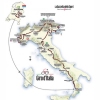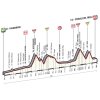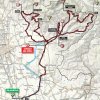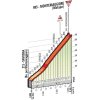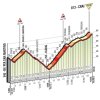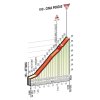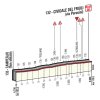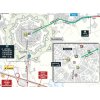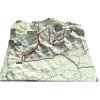Giro d’Italia 2016 Route stage 13: Palmanova – Cividale del Friuli
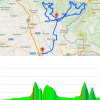
Slideshow 1/14
Friday, May 20th, 2016 - In stage 13 of the 2016 Giro d'Italia the riders face 161 kilometres between Pamanova and Cividale de Friuli. En route four mountains lay waiting. From head to tail the race is in the Friuli Venezia Giulia region, in the northwestern part of Italy. The finish is 13 kilometres after cresting the last peak.
After starting in the well preserved star fort Palmanova, roads are going steadily up for 42 kilometres. Nothing to be worried about, the average grade is just 0.5%.
Then comes the climb up Montemaggiore, close to the Slovenian border. The climbs totals at 8.3 kilometres with the first 2.5 kilometres at a 6.6% grade and the rest of the ramp at an impressive 10.5%.
Upon cresting the riders are awarded with a 14 kilometres drop, albeit the nosedive is interrupted by a 2 kilometres climb with a steepest 16% sector near the top.
Once in the valley the asphalt goes back up again with a 9 kilometres climb at 4.8%. That’s an average percentage and in fact the statistic is meaningless as the ascent to Crai is the apogee of irregularity. The first 4 kilometres come with an average gradient at 9.7%, so you can do the math regarding the second part.
A flat section of around 30 kilometres features a first passage in the arrival town and then two climbs close the stage. Cima Porzus, totalling at 8.75 kilometres, comes with a false flat opening kilometre before the rest of the climb brings an average grade at 8.6% and a steepest sector at 16% to the table.
Following an 11 kilometres drop the last climb appears. The road to Valle is 6.2 kilometres in length and goes up by a an average grade of 7.8%. A technical descent takes the riders to Campeglio and after 7 flat kilometres the winner raises his hands in glory in Cividale del Friuli.
At the line, time bonuses at 10, 6 and 4 seconds lay waiting, while intermediate sprints come with 3, 2 and 1 seconds each.
Race results/race report stage 13, Giro d’Italia 2016.
Giro 2016 Stage 13: Route maps, height profiles, etc
Click on the images to zoom
+ Click for more images (10)
Watch the highlights of recent races here:
Related articles Riders - Giro d'Italia 2016 Favourites and GC contenders - Giro d'Italia 2016 Route and stages - Giro 2016 More articles Tour of the Alps 2025: Live report stage 5
Tour of the Alps 2025 Route stage 5: Lienz – Lienz
Tour of the Alps 2025: Epic solo win earns Arensman leader's jersey
Liège-Bastogne-Liège 2025: The Route
Liège-Bastogne-Liège 2025: Riders
Liège-Bastogne-Liège 2025: Favourites
Liège-Bastogne-Liège Femmes 2025: The Route
Liège-Bastogne-Liège Femmes 2025: Riders
Cycling Calendar 2025
Giro 2025 Route stage 1: Durazzo - Tirana
Giro 2025 Favourites stage 1: Puncher's sprint for pink
Giro 2025 Route stage 2: Tirana - Tirana
Giro 2025 Favourites stage 2: Chrono specialists to the fore
Tour of the Alps 2025: Riders
Giro 2025: The Route
Giro 2025: Riders
Giro 2025: GC Favourites
Giro 2025 Route stage 3: Valona – Valona
Giro 2025 Route stage 4: Alberobello – Lecce
Giro 2025 Route stage 5: Ceglie Messapica - Matera
Giro 2025 Route stage 6: Potenza - Naples
Giro 2025 Route stage 20: Verrès – Sestrière
Tour de France 2025: The Route
Tour de France 2025 Route stage 1: Lille - Lille
Tour de France 2025 Route stage 2: Lauwin-Planque - Boulogne-sur-Mer
Tour de France 2025 Route stage 3: Valenciennes - Dunkirk
Tour de France 2025 Route stage 16: Montpellier - Mont Ventoux
Tour de France 2025 Route stage 18: Vif - Col de la Loze

